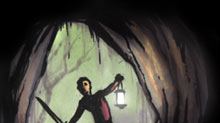 |
by Lee Valentine
Cave dweller Lee Valentine has ventured forth to the first ever PAX
East (Penny Arcade Expo) 2010 in Boston, MA. His observations,
revelations, and consternations are below. We invite you to post your
comments here.
OgreCave at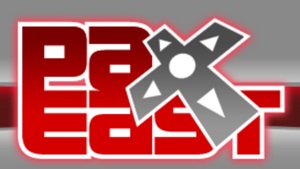
Hello, Cave dwellers – Lee Valentine here with the OgreCave PAX East
round up. Let me start by saying that the last console I played for
more than a couple minutes is the Sega Genesis, and the last time I
spent any significant time in the arcade was in 1990. I do play a
handful of PC games, but mostly those are ports of board or card games.
I watch a lot of sci-fi TV and play a lot of hobby games, but I am not a
regular convention attendee. I'm a hardcore gamer and also a comic
geek, but I rarely attend conventions or go to other types of geek
gatherings. As a result, PAX East 2010 was something of a system shock
for me.
Looking East
As another con attendee observed, PAX East showed some signs of a first
year show. At least one game I attended started 40 minutes late.
Unwieldy lines for panels sometimes wound in serpentine patterns, and
there were some other minor nuisances. That said, for the show's first
time at the Boston site, I thought the show was a good one, and there
was a lot of value for cost of entry. I would definitely attend again.
If I were to describe PAX East with one word, however, it would be
"queueing". I started by waiting in line for about 15 minutes to get
into the show, then I waited for an hour in a line for a game that was
starting very late, and then the game (unbeknownst to me) was going to
require me to stand in a queue as part of the game mechanic – I left
only shortly after the game started. [Action Castle, in case anyone's
curious. –Sven] As a result of not wanting to spend an entire
weekend standing in a queue, I only caught a handful of panels and
scheduled events.
Never having attended PAX before, I didn't know what to expect in terms
of game attendance. Most board and card gaming was played in the form
of pick-up games, with notable games like Dominion, Munchkin, Magic:
The Gathering and Puerto Rico having scheduled tournaments.
The rooms for free-gaming were often filled to the max, and the con
could have used more space for these games. Similarly, Wizards of the Coast's Dungeons &
Dragons events were overflowing with people who wanted to game but
couldn't, and they should have had more tables for events. The con's
play space seemed to me to be skewed toward electronic games: handhelds,
consoles, PC games, and even '80s arcade classics. However, it was
obvious that Boston really could handle a larger hobby game convention
than it currently has.
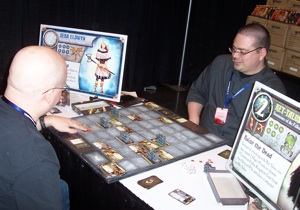 There were a handful of hobby game publishers other than the
prominently-placed Wizards of the Coast. Colby Dauch's company Plaid Hat Games was out in force
pushing Summoner Wars. Colby was showing off some new beta decks
for his game, and the one I played was very interesting, superior to the
ones I reviewed
here at the Cave. Zev Shlasinger's Z-Man Games was demo'ing Dungeon
Lords and Wasabi (Wasabi was a blast – thanks Paul and
Zev). Asmodee had Cyclades and
Claustrophobia. Steve Jackson
Games was out in force, pushing Zombie Dice, Cthulhu Dice,
Nanuk, and Revolution. I even saw Your Move Games'
Battleground being demo'd. Part of the dearth of hobby game
companies here was PAX's focus on video games, but part of it had to do
with the GAMA Trade Show (GTS) actually overlapping a day with PAX East
on opposite ends of the country. The guys from Steve Jackson Game
showed intestinal fortitude, by flying from GTS to PAX East, doing both
shows as best they could. All the hobby companies present really were
doing outstanding jobs supporting their products and doing demo after
demo. Most were focusing on allowing hobbyists to play a complete game,
while others were in the five-minute pitch mode. There were a handful of hobby game publishers other than the
prominently-placed Wizards of the Coast. Colby Dauch's company Plaid Hat Games was out in force
pushing Summoner Wars. Colby was showing off some new beta decks
for his game, and the one I played was very interesting, superior to the
ones I reviewed
here at the Cave. Zev Shlasinger's Z-Man Games was demo'ing Dungeon
Lords and Wasabi (Wasabi was a blast – thanks Paul and
Zev). Asmodee had Cyclades and
Claustrophobia. Steve Jackson
Games was out in force, pushing Zombie Dice, Cthulhu Dice,
Nanuk, and Revolution. I even saw Your Move Games'
Battleground being demo'd. Part of the dearth of hobby game
companies here was PAX's focus on video games, but part of it had to do
with the GAMA Trade Show (GTS) actually overlapping a day with PAX East
on opposite ends of the country. The guys from Steve Jackson Game
showed intestinal fortitude, by flying from GTS to PAX East, doing both
shows as best they could. All the hobby companies present really were
doing outstanding jobs supporting their products and doing demo after
demo. Most were focusing on allowing hobbyists to play a complete game,
while others were in the five-minute pitch mode.
Luke Crane, of Burning Wheel fame, was at PAX East pushing games
for Indie Press Revolution and running demos of his own games. He was
excited about his latest project called FreeMarket, a.k.a.
"Project Donut", a transhumanist RPG that he's been working on with
Jared Sorenson (which our own Mike Sugarbaker is fond of discussing from
time to time). Luke, an exceedingly friendly guy who loves his
products, also has a solid ability to pitch the products of his indie
RPG peers. I'm glad I got a chance to talk to him.
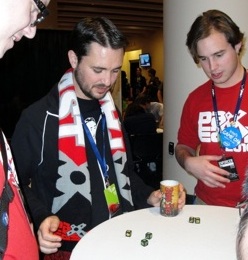 Wil Wheaton, once of Star
Trek: TNG, also showed the hobby side some love. He looked on
while I played Dungeon Lords, and then spent a fair bit of time
at the booth with Phil Reed, Will Schoonover, and the gang at Steve
Jackson Games. Wil gave a very humorous keynote address which had the
main theme that it's OK to be proud of being a gamer geek. My favorite
part of the speech was when he conducted an experiment to see how many
generations were in the room by using unexplained quotes from games as
applause lines. I believe "Shots do not hurt other players" was one I
remembered fondly from Gauntlet. There was also "Black Lotus,
Dark Ritual, and I summon a Sengir Vampire". The list goes on. Wheaton
was basking in the adulation the crowd had for him, for a man who was a
proud geek, and yet could comfortably straddle the line between geek
culture and the mainstream. Alas, I took a picture of Wil with the
folks at SJG, but my camera seems to have eaten the shot. Wil Wheaton, once of Star
Trek: TNG, also showed the hobby side some love. He looked on
while I played Dungeon Lords, and then spent a fair bit of time
at the booth with Phil Reed, Will Schoonover, and the gang at Steve
Jackson Games. Wil gave a very humorous keynote address which had the
main theme that it's OK to be proud of being a gamer geek. My favorite
part of the speech was when he conducted an experiment to see how many
generations were in the room by using unexplained quotes from games as
applause lines. I believe "Shots do not hurt other players" was one I
remembered fondly from Gauntlet. There was also "Black Lotus,
Dark Ritual, and I summon a Sengir Vampire". The list goes on. Wheaton
was basking in the adulation the crowd had for him, for a man who was a
proud geek, and yet could comfortably straddle the line between geek
culture and the mainstream. Alas, I took a picture of Wil with the
folks at SJG, but my camera seems to have eaten the shot.
[Note: The
folks at Steve Jackson Games were kind enough to let us use their shot
of Wil at the booth, taken by Phil Reed. –Sven]
I've talked about most of the hobby game publishers already, who were in
the tabletop gaming area. There were two notable ones in the big Expo
Hall: Wizards of the Coast and Star City Games. Both were supporting
Magic: The Gathering, and WotC was promoting D&D Insider, as a
bridge between one of its core product lines and the techie theme of the
Expo itself. Most of the companies in the Expo Hall were computer
manufacturers and video game companies. Again, this stuff is not my
forte, but I did my best to represent the Cave. I started by checking
out some of the smaller indie game publishers from the Boston metro
area, who had a special area set aside for them.
- Dejobaan Games was pushing
Aaaaa!, a game where you score points by engaging in all sorts of
silly behavior while falling off a skyscraper.
- Binary Takeover was
demo'ing Turba, a tile-based puzzler where the behavior of the
tiles is partially controlled by the music you are listening to on your
computer – you see, Turba is partially an MP3 player (there's a good chance you'll see at least a capsule review here on
OgreCave at some point).
- The Singapore-MIT GAMBIT game lab had a
variety of educational games and experimental game AI implementations.
I've guest lectured for an afternoon at MIT on game design theory, so I
had to return the favor by plugging them, since they're that little
college right up the street from where I went. :-)
 Other than two local game stores (The Compleat Strategist and
Pandemonium Books and Games), the last exhibitors in the tabletop gaming
areas that I spent time with were graduate students from Carnegie Mellon
University. They were showing off demos of how Microsoft's Surface
Table, an infrared-sensitive table, could be used as a
partially-automated DM tool to play Dungeons & Dragons: Fourth
Edition. Their project is called
Surfacescapes, a tremendous feat of computer engineering, both on
the part of Microsoft and the students at CMU. For now, I will let you
check out their website, but I hope that we can get them on a future
OgreCave Audio Report episode or Gaming News Update to let you hear more
about them. Other than two local game stores (The Compleat Strategist and
Pandemonium Books and Games), the last exhibitors in the tabletop gaming
areas that I spent time with were graduate students from Carnegie Mellon
University. They were showing off demos of how Microsoft's Surface
Table, an infrared-sensitive table, could be used as a
partially-automated DM tool to play Dungeons & Dragons: Fourth
Edition. Their project is called
Surfacescapes, a tremendous feat of computer engineering, both on
the part of Microsoft and the students at CMU. For now, I will let you
check out their website, but I hope that we can get them on a future
OgreCave Audio Report episode or Gaming News Update to let you hear more
about them.
I'd like to give a real shout out to Phil Reed and the good folks at
Steve Jackson Games for introducing me to their newer products. While
Cthulhu Dice had so little strategy that it wasn't my cup of tea,
Zombie Dice was quite fun as a light, filler, press-your-luck
game. Revolution! is the first Euro-style game I've seen out of
Steve Jackson Games – it had great components and was a blast to play.
I was helping to test out a proposed expansion for the game; the
expansion is slated for later this year if some print buying questions
can be answered. I will have to hold off on commenting on how the base
game plays with three or four, but I played the six-player game with the
expansion, and it was the most fun that I had playing a game at PAX
East, even including popular games like Dominion. I normally
don't do this, but I went out and bought a copy of the game immediately
after I'd played it. It was that fun, and SJG can quote me on that.
I want to extend my heartfelt thanks to all of the exhibitors in the
tabletop gaming area, because, feeling like a fish out of water, I
hovered around the familiar hobby games, chatted a lot, and asked a lot
of questions. Part of the reason I love hobby gaming is the people, and
these exhibitors really showed the fun, friendly, high caliber of people
that made me glad that I attended PAX East. Given the lower traffic of
the hobby gaming area, I got to spend quality time demo'ing games in a
way that I might not have at a dedicated hobby gaming convention.
Plugging in
OK, next, being a board gamer, I tried to find something familiar in
this sea of video games. I play a handful of PC games, and Hudson Soft
looked familiar. I checked out their game Rooms: The Main Building.
This is available on the PC already, and it's being ported over to the
Wii and the Nintendo DS. Remember those 15-piece sliding puzzle games –
you move tiles to the empty space to slide yet more things around to
eventually form a picture? That's Rooms, only you play a little
person trapped inside one of those puzzles, who must navigate them like
they are individual rooms. You try to push the rooms around to form a
complete picture so that you can escape. This concept appealed to me,
so I may try the demo on the PC. The Wii version was not for me, though
– I have decent hand-eye coordination, but I sometimes have microtremors
in my hands. So, I can do martial arts, but if I tried to be a brain
surgeon I'd lobotomize you accidentally about 90% of the time. Trying
to point the Wii at the tiny arrows in rooms was very frustrating for
me. The Nintendo DS version was more approachable, but too small for my
mediocre vision. Still, I think the game looks quite appealing.
Next, I'm a comic geek from back in the day, so I looked for things at
the show that were comic themed. Twisted Pixel gave a first glimpse of
Comic
Jumper: The Adventures of Captain Smiley. It was like a very
violent Saturday morning cartoon – it had an Earthworm Jim vibe
in terms of the art style (showing my aged Sega Genesis cred there,
huh?). Ska Studios had
The Dishwasher: Vampire Smile and Charlie Murder. Both
games had a gritty indie web comic vibe to them that drew me in for a
closer look. The former was a 2D action platformer, and the publisher
describes the latter as a "four-player arcade beat 'em up featuring all
four members of the revolutionary punk act who are on a crusade to
retrieve front man Charlie Murder's girlfriend, Skelekitten, from their
chart topping metal rivals."
While I didn't see the new City of Heroes when I
was in the Expo Hall, the new Going Rogue expansion was talked
about extensively at a Paragon Studios panel I attended, and I saw some
sample footage from the game. It was impressive if you are into things
superheroic. Going Rogue will allow you to convert your
experienced character from good to evil, or vice versa, in the City
of Heroes world. You have to go from good, to vigilante, to evil,
or from evil, to rogue, to good, over time. Paragon also showed their
upcoming Ultra Mode that really improves the shadows, reflections, and
all manner of texturing in the City of Heroes world – definitely
things to be excited about if you are into that game.
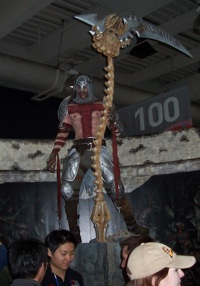 The Valentine award for the brand new game that feels
old school goes to Electronic Arts' Dante's
Inferno. The imagery was literally hellish, and was
disturbingly sexually lurid. This is a first person fantasy
hack-and-slasher whose gameplay is like a cross between Chakan: The
Forever Man and Rastan (showing my age yet?). You needed to
be highly caffeinated and have fantastic hand-eye coordination to
survive this one. The theme seemed to be that your lost love has been
dragged to hell and you need to save her. Nobody was explaining the
game, but I think I saw one bare-chested succubus that had a scorpion's
tail for a penis, and another giant she-demon was using her breast milk
to produce little angry demon children. Yes, if you were looking for
your acid trip, you found it. The Valentine award for the brand new game that feels
old school goes to Electronic Arts' Dante's
Inferno. The imagery was literally hellish, and was
disturbingly sexually lurid. This is a first person fantasy
hack-and-slasher whose gameplay is like a cross between Chakan: The
Forever Man and Rastan (showing my age yet?). You needed to
be highly caffeinated and have fantastic hand-eye coordination to
survive this one. The theme seemed to be that your lost love has been
dragged to hell and you need to save her. Nobody was explaining the
game, but I think I saw one bare-chested succubus that had a scorpion's
tail for a penis, and another giant she-demon was using her breast milk
to produce little angry demon children. Yes, if you were looking for
your acid trip, you found it.
The best sequel to an old classic was Prince of Persia: The
Forgotten Sands. This incarnation has all the acrobatic
exploration and time freezing of its fathers before it, but this time
with the ability to manipulate the elements. These time powers give the
game an added puzzle element that one-ups the "I must press the 'B'
button now" feel of the ancestors to this game.
Swag was being given away at the booth for Red Dead
Redemption, creating longer lines than I would tolerate to play
it, so I'm limited to reporting on the demo footage. This caught my eye
as probably the most immersive looking game in the Expo Hall. In this
Western-themed video game, you ride horses off into the sunset, chase
down outlaws, play games where you stab your Bowie knife between your
fingers at high speed, and there might have even been some poker, though
I can't verify the last one. It was gorgeous.
On the cutting edge tech front were NVIDIA and IMMERZ. NVIDIA was pimping their 3D
glasses and multiple-monitor gaming experience. Usable with hundreds of
Direct X titles (many military games and first-person shooters),
particularly with the multiple monitor setup, the NVIDIA PC upgrade kit
gave a very good since of depth, while the multiple monitor system
seemed to give you 90 to 120 degrees of perception if you can tolerate
the monitor bezels/frames dividing up that field a bit. IMMERZ had a
Kinetic Omni-Directional Resonance machine, a harness that analyzed the
audio tracks of your games and sent sonic vibrations into your chest.
The plug-n-play version was not really doing a lot for me; it felt like
a set of joy buzzers attached to my chest. The exhibitors assured me
that products specifically designed to take advantage of the technology
produce even more realistic kinetic simulations. It sounds like they
intend to port this product over to movie theaters to give you a kinetic
as well as audio experience. Having experienced the "butt kickers" at
IMAX theaters, I found the IMMERZ technology to be lacking, but then
again, maybe I wasn't using it with the right video game for the proper
experience. Since the technology has already won some industry acclaim,
what do I know?
While many of you are probably up on things concerning the video-music
gaming experience, particularly Guitar Hero and Rock Band,
I figure I should tell you about a pair of the more interesting add-ons
I saw at the show. OpenChord.org
was showing off some hardware in development to create guitars that you
could actually play chords on that would work with video game software.
The code was open source. The product looked only at proof of concept
stage, but I didn't have time to conduct an interview. PowerGig was a new, actual
six-string electric guitar with a wireless control system that allows it
to be used either with the PowerGig kit coming out around November of
this year or with games like Rock Band. When used with its
native software, this game is designed to teach you how to play an
electric guitar and jam out, not just hit the A & B buttons on a fake
guitar. The guitar was there; the software and drum kit was not.
Other Attractions
 Lastly, on the Expo Hall side of things, is couch potato gear and gaming
furniture. PlayOn is a
new software product that will allow you to watch streaming Hulu,
Netflix, CBS, Major League Baseball, and other media providers directly
on your Xbox, PS3, or Wii. Geek
Chic was showing off their absolutely opulent role-playing and board
gaming tables. If you've got thousands of dollars and want to blow it
on the most ridiculous gaming table imaginable, complete with fold-away
writing desks and cup holder, then check out Geek Chic. Lastly, on the Expo Hall side of things, is couch potato gear and gaming
furniture. PlayOn is a
new software product that will allow you to watch streaming Hulu,
Netflix, CBS, Major League Baseball, and other media providers directly
on your Xbox, PS3, or Wii. Geek
Chic was showing off their absolutely opulent role-playing and board
gaming tables. If you've got thousands of dollars and want to blow it
on the most ridiculous gaming table imaginable, complete with fold-away
writing desks and cup holder, then check out Geek Chic.
Being the 37-year old (almost 38-year old) gamer geek that I am, I felt
obliged to spend some time in the classic arcade that PAX East had on
display, courtesy of New England's own American Classic Arcade
Museum. It was a real treat to walk in there, not having been in a
real arcade in some years. Most amusing was watching player after
player die within seconds playing Dragon's Lair, the old Don
Bluth animated laserdisc video game system. It's still as impossible to
day on free play as it was back in the day with a pocket chock full of
quarters. My regret is that I didn't wait in line to play
Galaga, one of my favorite arcade classics.
Wrapping up
Well, as I've cleared the typical 2500+ words that I normally type for
feature length reviews, I'm
going to have to close out my PAX East report. Hopefully this has given
you some feel for the show and its contents.
Deputy Ogre Lee Valentine signing off.
P.S. Maybe someday with all my reporting I'll grow up to be a real Ogre,
but for now I'm just glad that I'm six feet tall and not classified as a Kua-Toa like poor
Steve. Hah. :-)
Have something to add? Leave your comments here.
|
 |
